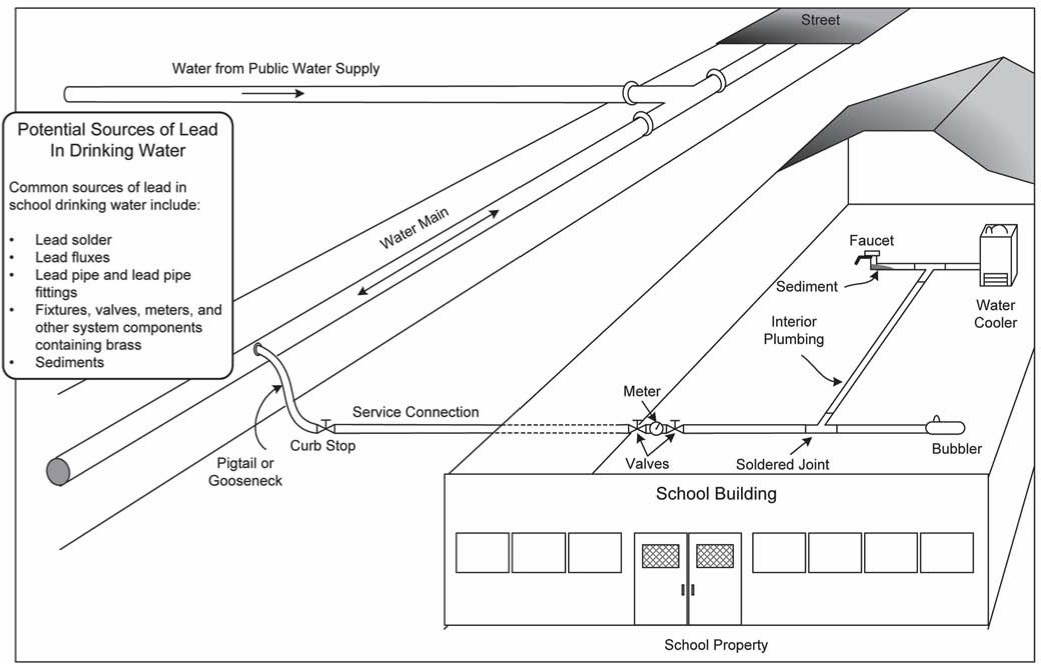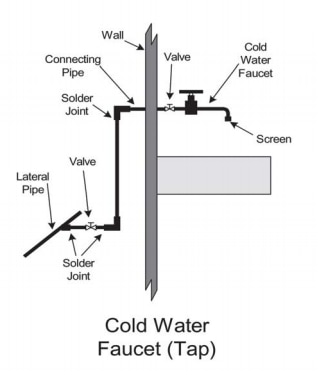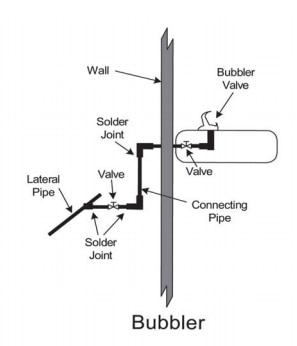The Lead Contamination Control Act (LCCA) was established under the federal Safe Drinking Water Act in 1988 to reduce lead in the drinking water of schools and childcare facilities. All schools (K‐12) and Early Education and Care (EEC) Programs facilities are covered under the LCCA. This includes facilities that are on a municipal water supply as well as facilities that have their own water source (such as a well, and thus are regulated by MassDEP as a public water system). The Massachusetts LCCA program includes both lead and copper, because the same mechanism that leaches lead from plumbing into the drinking water can also leach copper.
F.A.Q.'s
What is the LCCA?
The Lead Contamination Control Act (LCCA) was established under the federal Safe Drinking Water Act in 1988 to reduce lead in the drinking water of schools and childcare facilities. All schools (K‐12) and Early Education and Care (EEC) Programs facilities are covered under the LCCA. This includes facilities that are on a municipal water supply as well as facilities that have their own water source (such as a well, and thus are regulated by MassDEP as a public water system).
The Massachusetts LCCA program includes both lead and copper, because the same mechanism that leaches lead from plumbing into the drinking water can also leach copper.
Who Oversees the LCCA?
The Massachusetts Department of Environmental Protection (MassDEP) is responsible for managing the LCCA in Massachusetts. Partners include MA Department of Public Health (DPH), MA Department of Elementary and Secondary Education (ESE), MA Department of Early Education and Care (EEC) and the United States Environmental Protection Agency (US EPA).
Public water systems (PWS), your local board of health, and the MA Board of State Examiners of Plumbers and Gas Fitters also assist in sharing information on lead reduction.
How Does Lead Get into Drinking Water?
Most lead gets into drinking water after the water leaves the local well or treatment plant and comes into contact with plumbing materials containing lead. These include lead pipe and lead solder (commonly used until 1986) as well as faucets, valves, and other components made of brass. The physical/chemical interaction that occurs between the water and plumbing is referred to as corrosion. The extent to which corrosion occurs contributes to the amount of lead that can be released into the drinking water.
The critical issue is that even though your PWS may deliver water that meets all federal and state public health standards for lead, you may end up with too much lead in your drinking water because of the plumbing in your facility. The potential for lead to leach into water can increase the longer the water remains in contact with lead in plumbing. As a result, facilities with intermittent water use patterns, such as schools and day cares, may have elevated lead concentrations. Testing drinking water in schools and EEC facilities is important because children spend a significant portion of their day in these facilities and are likely to consume water while they are there. That is why testing water from your drinking water outlets for lead and copper is so important. Drinking water outlets are locations where water may be used for consumption, such as a drinking fountain, water faucet, or tap, or kitchen sinks.
How Does the Massachusetts LCCA Program Work?
MassDEP provides educational information and assistance to schools and EEC facilities on the LCCA. Every five years MassDEP requests updated information from these facility administrators about lead and copper monitoring and remediation efforts at their facilities. This updated information is used to provide additional training and technical assistance opportunities.
Schools and EEC facilities are encouraged to establish a sampling plan by identifying and prioritizing sample sites. MassDEP recommends that priority sample sites include drinking fountains (both bubbler and water cooler style), kitchen sinks, classroom combination sinks, home economics room sinks, teachers' lounge sinks, nurse's office sinks, sinks in special education classrooms, and any other fixtures known to be used for consumption. A recommended sampling plan would include sampling 1/3 (or a minimum of 10 per school) of the drinking water outlets annually to establish a baseline. These facilities should plan on re‐ sampling these sites every three years, including any new fixtures that are installed.
These tips below will help schools and EEC facilities organize and run lead and copper sampling plans smoothly.
Sample Plan
It is important to designate an employee at the school or EEC facility to take responsibility of developing the sampling program plan and the follow‐up activities, even if someone else is hired to conduct testing or if some tests are conducted by the PWS. If laboratory representatives or consultants are hired to conduct testing, the school/facility should ensure that the hired consultant has experience in conducting lead testing in schools and EEC facilities. They may wish to ask the laboratory or consultant for references. See Additional Resources below.
Determine Where to Collect Samples
Decide where to take samples and how to prioritize the sample sites based on the plumbing material and knowledge of the facility. At a minimum, every tap or fixture that is regularly used for cooking and drinking should be sampled. Sample sites that are most likely to have lead include:
- Areas containing lead pipes or lead solder
- Areas of recent construction and repair in which materials containing lead were used
- Areas where the plumbing is used to ground electrical circuits
- Areas of low flow or infrequent use
- Areas containing brass fittings and fixtures
- Water coolers identified by EPA as having lead‐lined storage tanks or lead parts should be removed (not just disconnected).
Diagram
Prepare a LCCA map, plan, or diagram of every tap and fixture that is used for drinking, cooking, or other human consumption purpose. Each tap identified should include information on the type of plumbing material for the tap and plumbing line leading to the tap. Please note that an existing building plan showing the plumbing can be used for the diagram. The facility LCCA map, plan, or diagram needs to be made available to the local public water supplier and/or any contractor that is hired by the facility to do sampling.
Assign Identification (ID) to the Taps
The ID should be placed on the diagram as well as made into a label for posting next to the actual tap or fixture. All parties (PWS staff, facility staff, contractors, etc.) that take samples or perform remediation on these fixtures should use this ID when reporting results or remediation efforts.
Rotate Sampling Taps
To allow for routine plumbing changes and repairs, it is recommended that the school or EEC facility sample and analyze their LCCA taps at least once every three years. A facility that has many LCCA taps can sample all LCCA taps in year one and then resample all of them three years later. Another option would be to rotate them; sample one‐third of the taps in year one, sample a second one‐third of taps in year two, and the final third in year three.
Sample Tracking
The school or EEC facility needs to track the date each LCCA tap was sampled, the results for each sample, and how the facility addressed any samples above the MassDEP recommended laboratory detection limit of 1ppb or above the Action Level for copper, if copper is included in the plan. A record of this information should be kept in a log or other record keeping device and made available to the local PWS or any other party conducting the next sampling round.
What does MassDEP recommend for a minimum voluntary Lead Contamination Control Act (LCCA) Program?
A school or Early Education and Care (EEC) facility voluntary program should do the following:
- Develop an updated list/map of all of the taps/fixtures used for drinking water, to prepare food and/or beverages, and in nurses' offices. All other non-human consumption taps should be posted with "For hand washing only".
- Use the MassDEP provided LCCA Program Management Tool (see Additional Resources below) to maintain and track the status of all identified sites. This Tool was developed for schools to use to manage their sampling sites, analytical data, and remediation actions.
- Develop and implement a Sampling Plan to sample the identified taps/fixtures at least once every three years after an initial baseline sampling of all identified fixtures. To balance cost and ensure that staff maintain their training on the sampling process, MassDEP recommends that 1/3 of the fixtures are sampled every year.
- Use a Massachusetts' certified laboratory to analyze all samples and require the laboratory to provide all results to the school AND to the MassDEP via MassDEP's electronic reporting system, eDEP.
- Remove from service all fixtures/taps that exceed the MassDEP copper action level or fixtures with lead detections above your school's lead shut down level (e.g. 15 ppb). Remediate and retest all fixtures/taps to ascertain that they do not exceed the action level before returning them to service. MassDEP's LCCA program recommends that schools and early education and care programs evaluate and remediate all taps/fixtures used for drinking, food preparation or medical uses with lead results above the Massachusetts certified laboratory detection limit of 1 ppb until the lowest possible concentration of lead is achieved.
- Develop and implement a transparent user friendly communication plan that provides timely notice to all student, staff, and parents about results and actions taken.
- Add all remediation and other actions to the MassDEP LCCA Program Management Tool.
If Your School or EEC Facility Is Provided Water by a PWS, What Sampling Does The PWS Provide that Can Help You In Your LCCA Program?
All community PWSs1 in Massachusetts are required by Massachusetts Drinking Water Regulations 310 CMR 22.06B (a) 9 to collect lead and copper samples from at least two schools or EEC facilities in each sampling period, as part of their Lead and Copper Rule (LCR) programs. Depending on the system’s water quality, a sampling period could be two times a year, once a year or once every three years.
Generally, these two samples, taken by a PWS, will not be enough to sample all taps within a facility. As such, schools or EEC facilities with routine plumbing changes are encouraged to collect and analyze additional samples to complete an evaluation of all taps within their facility at least once every three years.
How Does My Community PWS Choose which School or EEC Facilities to Sample?
A community PWS prepares for collecting the two school or EEC facility samples by developing a list of all schools and childcare facilities on their distribution system. This list is provided to MassDEP.
The community PWS collects two samples each sampling period, rotating through the list, until all schools and EEC facilities on the list are sampled. When the list is completed, they then start through the list again.
The facilities should provide their community PWS with their map, plan, or diagram of the taps in their facility that should be sampled. The school or EEC facility should have information on the last date that each tap was sampled, the results and any changes or repairs to the tap. This will help the PWS to avoid re‐sampling the same taps when there are other taps that have not been sampled.
How Does My Community PWS Provide Sampling Results to Schools and Early Education and Care (EEC) Programs?
A copy of all results is provided to the facility.
If results from the tap sampling are above the Action Level for lead or copper the PWS will notify the administrator of the school or EEC facility. The MassDEP Action Level for lead is 0.015 milligrams per liter (mg/L) or parts per million (ppm). Notification should include:
- clearly identified tap locations using the LCCA tap ID
- any recommendations to address the issue or technical assistance
- a list of local municipal officials, technical assistance providers including the board of health, the building department, plumbing inspector, and the local PWS.
What Should a School do with any Results that They Collect?
Schools and EEC facilities are encouraged to share their results with their staff, parents and students, local PWS, and their local city or town officials.
How Do Community PWSs Help Schools and EEC Facilities?
They provide an annual Consumer Confidence Report (CCR) with system‐wide lead and copper detections and information in it along with educational material.
They provide education and technical assistance to schools that may not be aware of the importance of checking for lead and copper leaching from the internal plumbing.
What Are Typical Questions Schools and EEC Facilities Should Ask Community PWSs?
- Is the water system in compliance with federal and state standards for lead monitoring and treatment?
- What steps has the community system taken to maintain compliance with the Lead and Copper Rule?
- Is the community’s water corrosive? If yes, what is being done to minimize/treat corrosion?
- Is a corrosion control chemical used? If yes, does the chemical form a protective coating inside the piping?
- Does the community’s water distribution system have any lead piping (for example, lead goosenecks at service connections or full or partial lead service lines)? If yes, what is the system’s plan to remove these sources of lead?
- Where can I get more information on lead and copper?
1 310 CMR 22.02 Public Water System means a system for the provision to the public of water for human consumption, through pipes or other constructed conveyances, if such system has at least 15 service connections or regularly serves an average of at least 25 individuals daily at least 60 days of the year. Such term includes any collection, treatment, storage, and distribution facilities under control of the operator of such a system and used primarily in connection with such system, and any collection or pretreatment storage facilities not under such control which are used primarily in connection with such system. The Department may presume that a system is a public water system as defined herein based on the average number of persons using a facility.
Additional Resources
- How to Develop a Sampling Program Plan
- LCCA Program Management Tool
- US EPA's "3Ts for Reducing Lead in Drinking Water in Schools"
- Set up an LCCA Program at Your School
-
Open PDF file, 1.9 MB, Lead in School Drinking Water Program 3Ts Follow-Up Actions Chart (English, PDF 1.9 MB)
-
Open PDF file, 385.73 KB, Tips on Operation & Maintenance for Point-of-Use Devices (English, PDF 385.73 KB)
-
Open PDF file, 457.56 KB, Fact Sheet: Flushing - A Short-Term Solution to Reduce Lead and Copper (English, PDF 457.56 KB)


